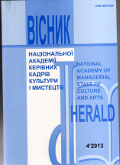The problem of mimesis in the history of the humanities
DOI:
https://doi.org/10.32461/2226-3209.4.2013.138062Keywords:
mimesis, art, imitation, creativity, artistic imageAbstract
The historical humanitarian discourse of the problem of mimesis, base aspects of of its analysis by different scientific spheres are researched. The main attention is paid to aesthetic aspects of mimetic problematique. The term "mimesis" functions for a long time in different scientific humanitarian contexts: aesthetic, psychological, art, culturological, sociological. There are main scientific vectors of its research: a) mimesis as psychological assimilation, suggestion, instinctive, spontaneous imitating nature; b) mimesis as socialized imitating in social-cultural formation of a person; mimetic problems of the philosophy of history, formation of public opinion, manipulations of mass consciousness; c) mimesis in artistic-cultural area as main factor of imaginative works and existing art at large. The consideration of aesthetic aspect of the problem begins in philosophy of the antiquity. Rome-Hellenism used theses of Greek philosophers, without making any own conception. The mediaeval thought confirmed mimesis as necessary imitation in art to signs and elements of God perfectness. Mimesis as imitation to nature, antiquity and recognized master has transferred into the central artisticaesthetic problem in Renaissance. The baroque and the classicism interpreted mimesis as artistic recreation of cultural reorganized natural surroundings, poetical ideas and metaphors were admitted as consequence of mimetic creation. In the sequel, two variants of interpretation were developed – as word for word reproduction and free reproduction; gradually the understanding mimesis as passive phenomenon, not enough corresponded to creative nature of the art, predominates. In ХVIII century, it was firstly said about fundamental for all kinds of art status of mimesis, which, however, was interpreted only as exact copying of beautiful nature phenomenon. This point of view dominated in subsequent period. The main accent was on plastic arts, the poetry was withdrawn from the sphere of mimesis` activity. The Age of the Enlightenment proclaimed the necessity of reconstruction the truthful reality. An aesthetic of XIX century showed the interest to mimesis in connection with discussing problems of realism and naturalism in art. In XX century it was sharp polarization of opinions: a) mimesis as an important base of image creation, b) complete denial of its artistic reasonability. Modern aesthetic considers mimesis as the way of artistic shaping of separate periods, first of all, classical art, but it contrasts it to the principals of free subjective figurative creativity in non-classical art, what levels real meaning of phenomenon, existing bulk of synonyms and interpretations makes its analysis harder. Each style period forms original mimetic type, which depends on vision paradigm, spiritual-value points, aesthetic awareness of the social medium and separate artists, developing technique base etc. and presents its own interpretation of the essence of the mimesis.Downloads
Published
Issue
Section
License
Authors who publish with this journal agree to the following terms:
1. Authors retain copyright and grant the journal right of first publication with the work simultaneously licensed under a Creative Commons Attribution License International CC-BY that allows others to share the work with an acknowledgement of the work's authorship and initial publication in this journal.
2. Authors are able to enter into separate, additional contractual arrangements for the non-exclusive distribution of the journal's published version of the work (e.g., post it to an institutional repository or publish it in a book), with an acknowledgement of its initial publication in this journal.
3. Authors are permitted and encouraged to post their work online (e.g., in institutional repositories or on their website) prior to and during the submission process, as it can lead to productive exchanges, as well as earlier and greater citation of published work (See The Effect of Open Access).


